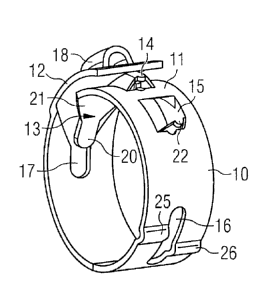Une partie des informations de ce site Web a été fournie par des sources externes. Le gouvernement du Canada n'assume aucune responsabilité concernant la précision, l'actualité ou la fiabilité des informations fournies par les sources externes. Les utilisateurs qui désirent employer cette information devraient consulter directement la source des informations. Le contenu fourni par les sources externes n'est pas assujetti aux exigences sur les langues officielles, la protection des renseignements personnels et l'accessibilité.
L'apparition de différences dans le texte et l'image des Revendications et de l'Abrégé dépend du moment auquel le document est publié. Les textes des Revendications et de l'Abrégé sont affichés :
| (12) Brevet: | (11) CA 3040555 |
|---|---|
| (54) Titre français: | COLLIER DE SERRAGE |
| (54) Titre anglais: | CLAMPING CLIP |
| Statut: | Octroyé |
| (51) Classification internationale des brevets (CIB): |
|
|---|---|
| (72) Inventeurs : |
|
| (73) Titulaires : |
|
| (71) Demandeurs : |
|
| (74) Agent: | KIRBY EADES GALE BAKER |
| (74) Co-agent: | |
| (45) Délivré: | 2022-07-19 |
| (86) Date de dépôt PCT: | 2017-07-11 |
| (87) Mise à la disponibilité du public: | 2018-05-11 |
| Requête d'examen: | 2019-04-15 |
| Licence disponible: | S.O. |
| (25) Langue des documents déposés: | Anglais |
| Traité de coopération en matière de brevets (PCT): | Oui |
|---|---|
| (86) Numéro de la demande PCT: | PCT/EP2017/067357 |
| (87) Numéro de publication internationale PCT: | WO2018/082819 |
| (85) Entrée nationale: | 2019-04-15 |
| (30) Données de priorité de la demande: | ||||||
|---|---|---|---|---|---|---|
|
L'invention concerne un collier de serrage constitué d'une bande de serrage (10) dont les deux parties d'extrémité (11, 12) se chevauchent lorsque le collier de serrage est fermé. Une languette (13) située sur la partie d'extrémité intérieure (11) recouverte de la bande se loge dans un canal pour languette (17) situé sur la partie d'extrémité extérieure (12) de la bande qui recouvre la partie d'extrémité intérieure (11), la forme de ce canal étant complémentaire de celle de la languette (13). La languette (13) comprend une zone de base (21) dans laquelle sa largeur, mesurée dans la direction axiale du collier de serrage, diminue de la pleine largeur de la bande de serrage à une valeur minimale, ainsi qu'une zone d'extrémité (20) qui s'étend dans le prolongement de la zone de base (21) et dans laquelle sa largeur présente constamment la valeur minimale.
The clamping clip described here consists of a clamping band the two end
portions of which overlap each other in the closed condition of the clamping
clip. A
tongue disposed on the overlapped inner band portion is received by a tongue
channel provided on the overlapping outer band portion, the shape of the
tongue
channel being complementary to the shape of the tongue. The tongue has a root
part
in which the tongue width, measured in the axial direction of the clamping
clip,
decreases from the full clamping band width to a smaller value, and an end
part
adjoining the root part, in which the tongue width constantly has the smaller
value.
Note : Les revendications sont présentées dans la langue officielle dans laquelle elles ont été soumises.
Note : Les descriptions sont présentées dans la langue officielle dans laquelle elles ont été soumises.

Pour une meilleure compréhension de l'état de la demande ou brevet qui figure sur cette page, la rubrique Mise en garde , et les descriptions de Brevet , États administratifs , Taxes périodiques et Historique des paiements devraient être consultées.
| Titre | Date |
|---|---|
| Date de délivrance prévu | 2022-07-19 |
| (86) Date de dépôt PCT | 2017-07-11 |
| (87) Date de publication PCT | 2018-05-11 |
| (85) Entrée nationale | 2019-04-15 |
| Requête d'examen | 2019-04-15 |
| (45) Délivré | 2022-07-19 |
Il n'y a pas d'historique d'abandonnement
Dernier paiement au montant de 210,51 $ a été reçu le 2023-06-27
Montants des taxes pour le maintien en état à venir
| Description | Date | Montant |
|---|---|---|
| Prochain paiement si taxe applicable aux petites entités | 2024-07-11 | 100,00 $ |
| Prochain paiement si taxe générale | 2024-07-11 | 277,00 $ |
Avis : Si le paiement en totalité n'a pas été reçu au plus tard à la date indiquée, une taxe supplémentaire peut être imposée, soit une des taxes suivantes :
Les taxes sur les brevets sont ajustées au 1er janvier de chaque année. Les montants ci-dessus sont les montants actuels s'ils sont reçus au plus tard le 31 décembre de l'année en cours.
Veuillez vous référer à la page web des
taxes sur les brevets
de l'OPIC pour voir tous les montants actuels des taxes.
| Type de taxes | Anniversaire | Échéance | Montant payé | Date payée |
|---|---|---|---|---|
| Requête d'examen | 800,00 $ | 2019-04-15 | ||
| Le dépôt d'une demande de brevet | 400,00 $ | 2019-04-15 | ||
| Taxe de maintien en état - Demande - nouvelle loi | 2 | 2019-07-11 | 100,00 $ | 2019-04-15 |
| Taxe de maintien en état - Demande - nouvelle loi | 3 | 2020-07-13 | 100,00 $ | 2020-06-30 |
| Taxe de maintien en état - Demande - nouvelle loi | 4 | 2021-07-12 | 100,00 $ | 2021-07-01 |
| Taxe finale | 2022-05-19 | 305,39 $ | 2022-05-03 | |
| Taxe de maintien en état - Demande - nouvelle loi | 5 | 2022-07-11 | 203,59 $ | 2022-06-21 |
| Taxe de maintien en état - brevet - nouvelle loi | 6 | 2023-07-11 | 210,51 $ | 2023-06-27 |
Les titulaires actuels et antérieures au dossier sont affichés en ordre alphabétique.
| Titulaires actuels au dossier |
|---|
| OETIKER SCHWEIZ AG |
| Titulaires antérieures au dossier |
|---|
| S.O. |